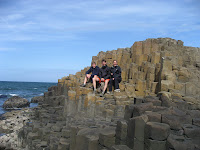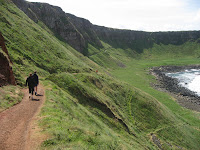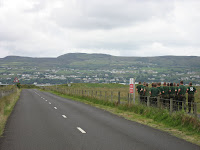For Steve's account of our time in Ireland,
click here.
Jun 5-16
Four years ago, when Jess and I toured Ireland, we stayed with my aunt Ena and her husband Jim in their quaint cottage on a remote peninsula in Donegal. After welcoming us with delicious quiche and chocolate cake and other forms of hospitality, Ena gave me the key to their old house in Larne, and said we should make use of it sometime. For this visit to Ireland, we took her up on it.
As Ena called it, we had "a pig of a journey" to get from Shrewsbury to her house outside Larne. We had a train from Shrewsbury to Crewe, Crewe to Carlisle on the Scotland border, a wonderfully scenic bus ride through Scotland to Stranraer, a taxi to the neighboring port of Cairnryan, the ferry across the Irish Sea to Larne at sunset, and then a final, short taxi ride to Ena's house on Ballypollard Road in Magheramorne, just south of Larne city. I've had incredible luck throughout my travels, transport included, and this chain of made connections was no exception. Welcoming us to the house were a nice note from Ena, delicious quiches, chocolate cake, and various other sweeties, not to mention bottles of wine and Southern Comfort. Jess and I explored the beautiful old house and made ourselves at home.





I titled this blog entry "Ireland" to keep it simple, but, in fact, we spent most of our time in Northern Ireland, a part of Great Britain, and comparatively less time in the Republic of Ireland, or "Southern Ireland" as many British call it. But this distinction is a big one, something we would learn much more about.
The day after we arrived in Magheramorne, we were having a nice talk with neighbor Jim, his daughter, and puppy when Steve showed up to join us for the next two weeks. It was great to see an old friend, and we spent the rest of the evening catching up, taking the train to Larne to get groceries, and cooking our first dinner.


Steve quickly cracked the whip and got us organized for our upcoming bicycle trip. Jess and I had started looking forward to the end of our trip, so we appreciated having a busy schedule for our remaining time. The day after Steve arrived, we took the train into Belfast, went to the Saturday St. George's market, picked up accommodation information and maps, and rented touring bicycles with panniers. After quiche lunch in the Botanic Gardens park, we cycled past the "peace lines" (high walls and fences to separate Catholic and Protestant neighborhoods) to Ardoyne, a low-income Catholic neighborhood with many moving murals.





We continued to northern Belfast and visited the houses where my Dad and Mum had grown up.


Finally, we cycled back to Larne, and Steve cooked up his first of two scrumptious Indian meals for our delight, followed by generous slices of Ena's chocolate cake. What a day!

The following day, we set off by bicycle to tour the Antrim coast the Inishowen peninsula. Our routine consisted of cycling in the morning, lunch at a town pub, cycling in the afternoon, sometimes interspersed with sight-seeing, checking into a hostel, and either cooking dinner or going out. The simple, cycle-tourist schedule.




Day 1: Magheramorne to Cushendall, 31 miles
After exploring by bicycle the rather dead town of Larne, we set off northward on the famous "Antrim Coast Road", which was quite busy with traffic, probably since it was a Sunday. We had two cars of drunken teenagers scream at us as they whizzed by, and we were passed by a few motorcyclists going about 70 mph on the small, winding road. Fortunately, that was the only unpleasant traffic we would experience.
Perfect weather accompanied breathtaking scenery as we wound along the coast, stopping for lunch at a bench overlooking the sea just before Ballygalley. A local man on bicycle stopped to chat with us, having just cycled to make a deposit at the bank.



At Glenarm (where my great uncle used to run the general store), we explored a forest path. At Glenariff, we took a detour into the glen, painted with yellow scruffy gorse.




At Cushendall, we checked into our nicest accommodation of the trip, a B&B next to a farm outside of town. Unladen, we cycled into town covered in beautiful, soft yellow sunlight, and had our first of many large pub meals with Guinness.

Day 2: Cushendall to Bushmills, 30 miles
We started the day with our first Antrim Fry breakfast: cereal and yogurt followed by egg, bacon, sausage, three kinds of toast, jam, and tea. Our stomachs were a bit bloated for the steep up and down hills to come, though with great scenery, past Torr Head and our first glimpse of Scotland. We stopped at Ballycastle for lunch and Steve and I had our first disc toss of the trip -- at long last! I hadn't thrown a disc since Chiang Mai.


As we turned left along the Antrim Coast, we faced incredible headwinds which would keep at us for the next few days. We stopped off at the Carrick-a-rede rope bridge to scramble across through a 28 mph crosswind.




Day 3: Bushmills to Portrush, 12 miles
After our standard hostel breakfast of muesli, milk / yogurt, and fruit, we cycled to the Giant's Causeway and barely beat the crowds, providing for a magical couple of minutes with the place almost to ourselves. After walking around the hexagonal pillars, we took the scenic walk overlooking the bay.




Next stop was the Old Bushmills Distillery, celebrating its 400th year. It was a well-done tour, lacking only because the distilling and bottling areas were closed that day. The tasting wasn't as easy to enjoy as a brewery's with our inexperienced palettes, but we managed to enjoy ourselves.

We picked up our stored panniers from the Bushmills hostel and headed on to Portrush, a vacation and amusement town where my Dad used to take his Mum to play bingo, or more specifically pongo, a variant on bingo. First stop was Barry's, the huge amusement park on the main street that was there from my parents' time. We stopped in for some good fun on the cheap slot machines and 2p coin games.

One of my primary objectives since planning this trip to cycle the Antrim Coast was to find the bingo hall where my dad and grandma used to play bingo. So we set off trying to find old Blundell's, off the main street. We stopped into a place called Phil's Amusements. Somehow, I had a feeling that this used to be Blundell's.

After making some inquiries with the staff at another amusement hall, I learned my hunch was right! As fate would have it, Phil's had bingo on that night, so we checked into a B&B and rushed back to catch the game, arriving a little late -- just like my Dad and granny might have. The bingo was much more relaxed and friendly than in St. Austell, the bingo caller entrancing us with his sing-song and rhyming calls, and even addressing the white-haired ladies by name when they won. Afterwards, I approached the caller and told him about my mission to play bingo where my Dad and Grandma had. He enjoyed my story so much that he produced an old pongo board that they didn't use anymore: "Give this to your father, he would appreciate it". I spent the rest of the evening walking around town with this pongo board, making a great conversation-starter with strangers.

Day 4: Portrush to Moville (Inishowen), 27 miles
After checking out a few others of my Dad's old haunts around Portrush, including the Ramore Head tennis courts and the Portstuart strand (beach), we headed on to Coleraine where we stopped at a bike shop to pump our tires, lube our chains, and chat with the mechanic. He spoke highly of cycling in Inishowen, our terrain to come.

We struggled through more headwinds and Kansas-like flatlands, stopping for lunch outside a closed restaurant, to Mugilligan Point where there is a ferry across to Inishowen. We passed a huge jail and army training center leading up to the ferry.



Soon after arriving in Inishowen, Steve's rear tube exploded dramatically, likely due to the pumping we had given it earlier that day. Back when we rented the bikes, I questioned why we were given a set of box wrenches when all the bolts on our bikes had Allen heads, and told them we didn't want the box wrenches. I was flabbergasted when I realized that Steve's blown rear wheel was the only of our six that required a box wrench to remove. Fortunately, we had just arrived in Ireland, land of the ever friendly and generous. Across the street, I noticed a man out in front of his house. When I explained what happened, he immediately invited in, lent us a wrench, and went on to feed us tea and biscuits and showed us his guidebook for Inishowen. After a great long talk with him and his daughter, we were on our way to the Moville Hostel which turned out to be a 19th-century stone building full of character, well-renovated and mostly clean. We had stumbled upon a gem of a hostel, complete with a friendly Iranian proprietor.

My stomach was hurting after dinner, so I stayed in while Steve and Jess tried their hand at a local pub quiz. The locals-oriented questions had them stumped.

Day 5: Moville to Malin Head, 25 miles
On our way out of the hostel, a woman drove down the driveway and struck up a conversation with us. She offered a tour of the nearby stone bridge, fabled to be built by St. Patrick himself. The bridge spanned a little river flowing in one direction, and steps later there was another river running antiparallel to the first. Due to this mystical occurrence, the woman explained, St. Patrick and other monks from the nearby monastery would spend time here.

After some chilly riding, stopping at the overgrown Cooley Cross, to a hotel pub lunch stop in Culdaff, we headed on to Malin Head, the most northerly point in Ireland. The landscape was classic Donegal: harsh, craggy, and peaty, much like what I had seen eight years ago cycling through Conemara.





That night, we spent the evening at the town pub. The Guinness we had been drinking along our trip was served much colder than my memory, not as good as the old days, so I struck up a conversation with the bartender and the locals about it. Many opinions were voiced, and the bartender even offered me a pint of the brown stuff at whatever temperature I wished, saying he could alter it by warming the glass in a tub of warm water. We learned there used to be undercover Guinness tasting officials, sent around by the brewery to test the quality and presentation of their beer, but this ritual had ended in the mid-90s. Cold beer foams less and thus is faster to pour on a busy night. The puzzle pieces were coming together.

Day 6: Malin Head to Buncrana, 31 miles
Easier riding and beautiful scenery today, stopping in Malin town for a snack and a toss on their pristine triangular town green.

After lunch, we noticed that our road seemed to climb incredibly into the mountain, and so we stopped to confirm we were on the right track. "You'll be pushin' for a while", the local said with a grin. We thought that "pushin'" was a quaint, colloquial way of saying "pedaling hard", but it turned out he meant literally pushing our bikes uphill. For quite a while. But experiences like that just confirm my opinion that cycling in hilly terrain is preferable to flat land – you get the contrast of challenging uphill and coasting downhill, landscapes from the top and intimate views of houses and animals on the way up. Unending flat land of farms and pastures gets old. Unfortunately, the downhill was equally steep and long, so we were white-knuckled on the brakes the whole way down.



Day 7: Buncrana to Derry, 17 miles
For our last day of cycling, we took the scenic route around Inch Island, getting off the beaten path (even though the "beaten path" was a small road on a remote peninsula). As in many other places, we saw signs of premature development resulting from Ireland's "Celtic Tiger" phase in the 1990s. It was depressing to see American-like suburbanization, along with years-old new houses that had never been sold or lived in.





We spent two days in Derry, smaller than but similar to Belfast in that it was a hot spot during the Troubles. We took a walking tour of "The Bogside", a poor, nationalist (Catholic) neighborhood outside the Derry city walls and the sight of Bloody Sunday. The tour was given by a nationalist woman who was a teen when the Troubles began, and it was interesting to hear her partisan and quietly passionate account. In her opinion, the conflict in Ireland finds its routes in the Derry city walls, which were built in the 17th century by The Honourable The Irish Society, who owns them to this day. The Irish Society, despite its name, is based in London. The walls represent England's control over the Irish, who were relegated to the marshy "bogside" of the river. [The third photo here is actually a Protestant mural from the Protestant side of the river.]



Derry was a real city, with small local pubs and their local drunks, a night scene, working-class people and poverty, palpable history, hoodlum youth, and Euro 2008 soccer madness.
